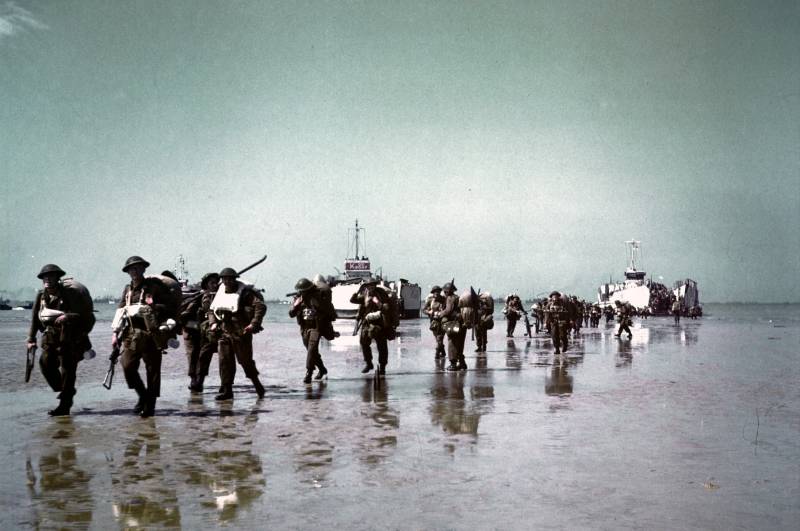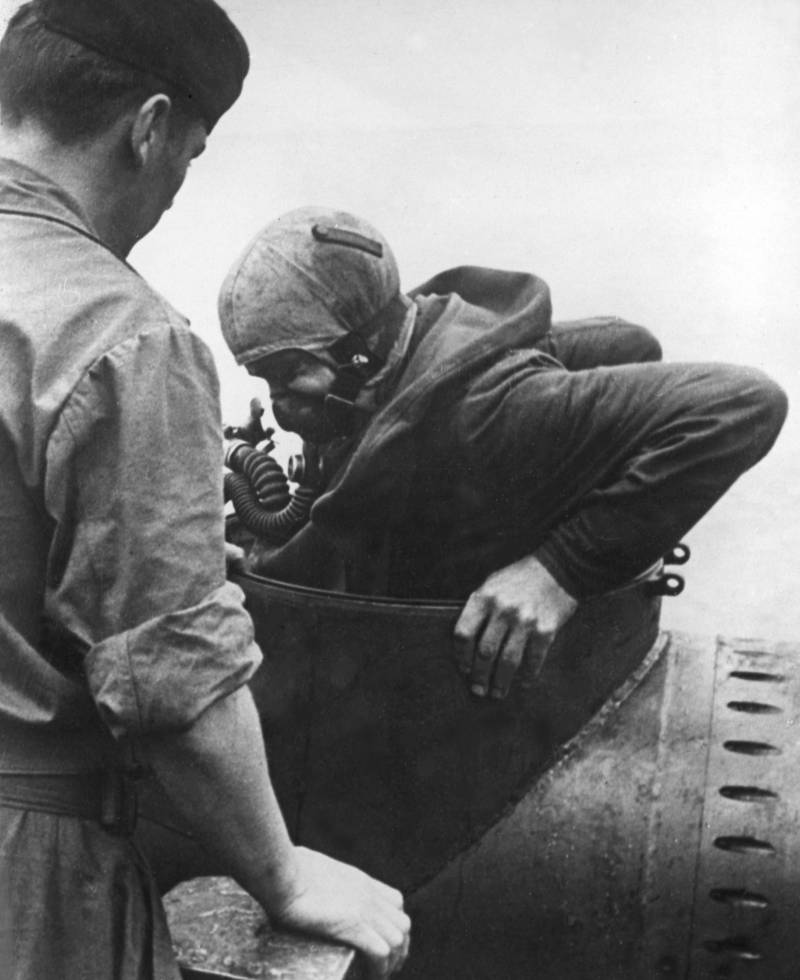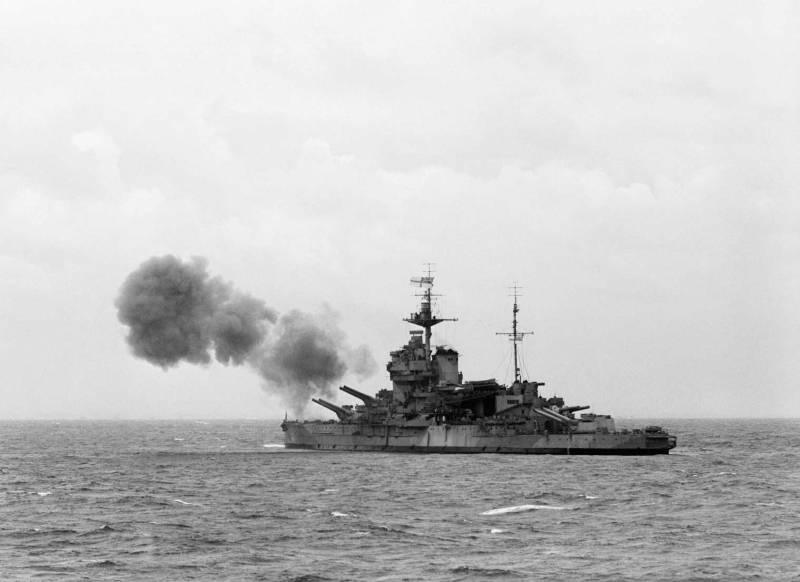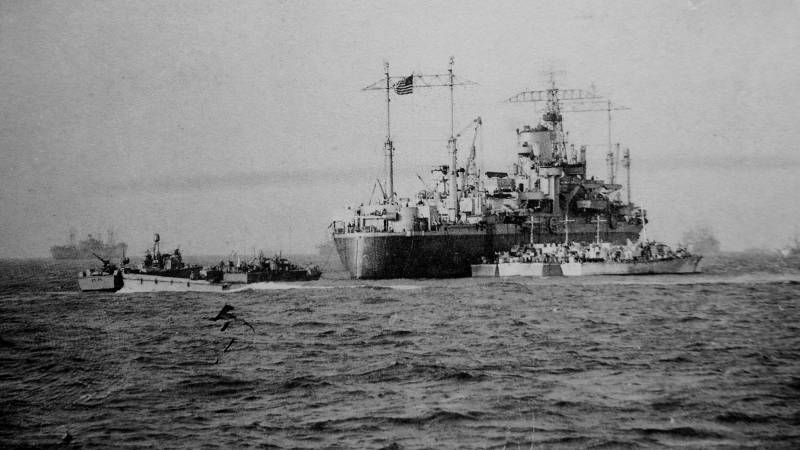Kriegsmarine combat swimmers: landing in Normandy
- considered the State Councilor of the Third Reich Rudolf Blom.
Despite the extremely voluminous Russian historiography dedicated to World War II, many episodes of the hostilities that were waged by our allies in the anti-Hitler coalition remain extremely little known to us.
The countermeasures of the opposing side are no less secret - and one of such episodes was the landing in Normandy.
Very often those events are described solely from the point of view of land confrontation. By default, it is believed that the Germans did not really try to resist the Allied naval invasion. And the topic of our conversation today will be devoted to this particular episode.
Landing in Normandy
- from the notes of the midshipman Karl-Heinz Pothast, a naval saboteur of the "K" formation.
After the relatively successful debut of naval saboteurs in Anzio, Germany produced a new batch of human torpedoes.
Formation K was already preparing to receive weapons and again immediately go to Italy, but the situation changed dramatically. The German command correctly interpreted the intelligence signs - more and more evidence of the impending Allied invasion of France began to be discovered.
The Germans assumed that the landing would take place on one of the sections of the French Atlantic coast - in the English Channel or Pas-de-Calais. The command of the naval forces understood that the allies would concentrate for this purpose a huge number of warships and, accordingly, could easily suppress any attempts by the German Navy to inflict a landing the fleet allies at least some tangible losses in the naval war.
And yet the remnants of the German Kriegsmarines needed to fight. The German fleet prepared to attack the enemy every night with all available ships that could only carry guns or torpedo tubes on board.
Formation K was also to take part in these attacks, including the Neger man-controlled torpedoes.
Despite the prejudices among the command that reigned in relation to the asymmetric means of naval warfare, during the operation in the area of the Anzio-Nettun bridgehead, they proved their combat value. In turn, the naval saboteurs demonstrated outstanding qualities that testified to their ability to achieve their goals.
However, despite this, the Nazis understood perfectly well that in order to organize such a large foothold for the invasion, the British and Americans would have to provide strong and reliable security. Accordingly, the entire armada of allied destroyers, cruisers, gunboats, torpedo and patrol boats could, in the shortest possible time, create an environment in which the combat activities of the Neger would be completely paralyzed. The Germans, however, hoped that until then they would get at least a few nights.
Several nights, during which the human torpedoes will have time to collect a bloody harvest, using their main trump card - surprise.
The command of formation "K" took into account all the mistakes and difficulties of the "Italian debut", having previously sent their operational inspector to the area of the enemy's invasion. Its main task was to ensure the most favorable conditions for the normal launching of flotillas of small sabotage and assault weapons arriving in the area of hostilities.
Captain First Rank Fritz Boehme was appointed as inspector. Under his command was transferred a solid cargo convoy, which immediately transported 40 "Neger" with pilots and technical personnel. A forest a few kilometers off the coast of the Seine Bay was chosen as an operational base. In turn, the launching site was found in the nearby small resort of Ville-sur-Mer, which was located about 10 km south-west of Trouville.
The main concern of Fritz Boehme was to ensure the smooth launch of the Neger to the water. The Inspector had studied the reports well and was aware of all the difficulties that the naval saboteurs faced during the raid on Anzio.
This time, two sapper companies were attached to Formation K, whose task was to prepare the coastline. They made passages in a dense network of wire, mine and anti-tank obstacles along the coastline, which led to two long half-dams (buns). These structures turned out to be extremely useful for the purposes of combat swimmers: at low tide they found themselves quite far out to sea, and at high tide they were flooded. The groins were modified - the sappers erected wooden descent paths on them, which took them even further into the sea.
Thus, at high tide, it was possible to easily roll out carts with "Neger" directly into the sea. Of course, this greatly facilitated the difficult task of deploying combat craft.
So, on the night of July 6, 1944, German man-controlled torpedoes delivered the first blow to the Allied invasion fleet in the Seine Bay.
Unfortunately, no detailed description of that battle has survived. It is only known that the Germans launched 30 devices.
The combat successes of the compound were extremely modest - at the cost of the lives of 16 pilots, the Nazis managed to torpedo only two Allied ships.
The next night (7 July) the Germans decided to repeat the attack. At 11 pm, the human torpedoes set off again on a mission.
Next, let's give the floor to a direct participant in those events - midshipman Karl-Heinze Pothast:
About 3 hours. 30 minutes. I heard the first explosions of depth charges. Shots were also heard, but this time the anti-aircraft guns did not hit aerial targets. Probably, one of ours was spotted in the moonlight, or found another way. After all, now our sabotage sortie, unfortunately, was no longer sudden for Tommy.
The depth charges did not cause any harm to me, I felt only a slight concussion. For about 15 minutes I did not move, waiting for further events to unfold. A group of merchant ships passed on the left side, but it was too far away, and besides, I had already got it into my head that I had to sink only a warship.
Continuing to sail, at about 4 am I saw a destroyer not far away and established that it belongs to the Hunt class. But when I approached 500 m, he turned to the side. The low speed of the Neger did not give me any chance to catch up with him. The excitement at sea increased somewhat. I noted with satisfaction that I did not feel fatigue or other signs of deterioration in my physical condition, although I had already been at sea for more than 5 hours.
After another 20 minutes, I saw several warships ahead on the left, marching in formation of a ledge. They crossed my course. The largest of the ships sailed last, at the farthest distance from me. I figured that I would probably be just in time to reach the torpedo attack distance of the last ship, unless the formation changed course. We were getting closer quickly. Then the two forward ships began to turn around, probably in order to rebuild. The latter, who now seemed to me to be a large destroyer, was apparently waiting for the leading ships to complete their maneuver. He walked at the slightest pace. It even seemed that he was turning at anchor. I was getting closer to the big destroyer every minute. When the distance to the enemy ship was about 500 m, I once again remembered the rule that I myself taught my junior comrades: do not release a torpedo prematurely, continue to improve my position. And now there were only 400 m left - the enemy turned more and more sideways towards me, that's only 300 m - and I fired my torpedo ...
Then he immediately turned to the left. When I fired, I forgot to time it. For a terribly long time nothing was heard. I was about to hang my head in complete disappointment, when suddenly a blow of incredible force rang out under the water. The Neger almost jumped out of the water. A huge column of flame shot up into the sky on the stricken ship. A few seconds later, the fire already blinded me, thick smoke overtook my torpedo and tightly enveloped it. For a while, I completely lost the ability to navigate.
It was only after the smoke cleared that I saw the struck ship again. A fire was raging on him, he gave a roll. His silhouette was significantly shortened, and I suddenly realized that his stern had been torn off.
Other destroyers at full speed approached the burning ship, throwing depth charges. The waves from the explosions rattled my carrier torpedo like a piece of wood. The destroyers fired indiscriminately in all directions. They didn't see me. I managed to slip out of the zone of the most effective fire of their light airborne weaponswhen they, abandoning the pursuit of an unknown enemy, hastened to help the damaged ship. "
Ironically, Midshipman Pothast was one of the few first set of German naval saboteurs to survive the war.
And he, among other things, turned out to be the most effective pilot of the Neger man-torpedoes. In the end, it was Karl-Heinz who torpedoed the largest loot of the K compound - the light cruiser Dragon of the Polish emigration naval forces.
Gloomy results
After the battle on July 7, Formation K suffered significant losses.
Many cars and pilots were lost - even then it became clear that the capabilities of the "Neger" were exhausted, but the command sent them into battle twice more.
The next attacks took place at the end of July, as well as on the nights of 16 and 17 August 1944. The successes, frankly, were not impressive - the most notable of them was the torpedoing of the British destroyer Isis.
By the time of the landing in Normandy, the allies had almost complete information not only about the combat capabilities of the "Neger", but also knew extremely much about the activities of the "K" unit (up to the presence of personal files for the ordinary servicemen of the unit). The use of human torpedoes did not come as a surprise to them - on the contrary, it was expected and prepared for it.
The British and Americans organized a layered defense system. And after the raid on Anzio, the Negera were not an unpleasant surprise for the sailors of the anti-Hitler coalition.
The main advantage of human torpedoes - surprise - was lost. And in Normandy, German saboteurs over and over again went to certain death.
Продолжение следует ...




Information